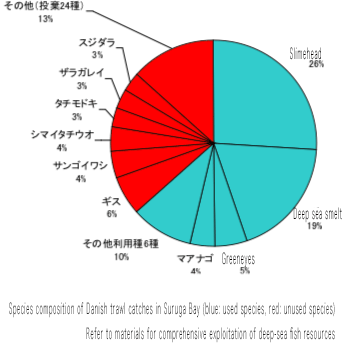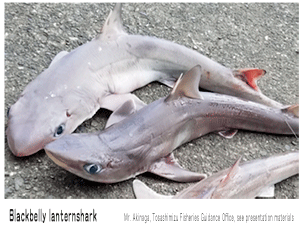| Please access the following URL if you want to secure using SSL. All pages in the site will be secure pages. |
https://secure02.blue.shared-server.net/www.fish-food.co.jp/message english 5.2023.html |
Welcome to FISH FOOD TIMES
May. 2023 issue No.233

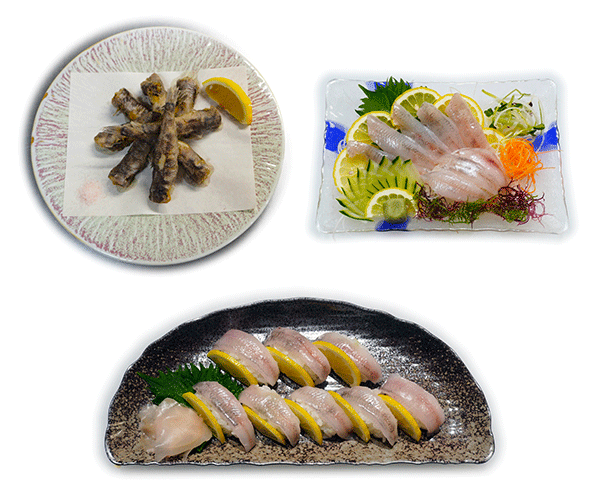
Mehikari (Greeneyes) Cuisine
Greeneyes and Round Greeneyes
In this month's issue, I was able to obtain Mehikari (Greeneyes), which is rarely available in Fukuoka, where I live, so let's write an article on this fish.
The image below is of the Mehikari (Greeneyes) I obtained.

The name Mehikari is a general name that is used throughout Japan, and the standard Japanese name is Aomeeso. However, there is a fish of the same strain with Round Greeneyes, and these two species are so similar that even experts in the field cannot easily tell them apart.If both species were available for comparison, we might be able to explain the difference, but that is not possible. At my current level of knowledge, I could not clearly distinguish between greeneyes and round greeneyes.
I was in charge of the fresh fish department of a supermarket in Miyazaki Prefecture for two years in 1977 and 1978, so I have definitely dealt with Mehikari at that time. However, I haven't had many chances to handle Mehikari since then, so my memories of it are vague. According to my memory at that time, it was "Mehikari's eyeballs were bigger and transparent like crystal, the fish body was a little bigger, and the color of the fish body was brighter than this dark."
So, when I bought this fish at the store, I saw the Mehikari on the sales floor and thought it was a little different from the Mehikari I remembered. And when I looked into Mehikari later, Greeneyes live mainly in the deep waters off the coast of Aichi, Shizuoka, Kochi, and Miyazaki Prefectures, relatively south of Japan. On the other hand, it was found that the main production areas of Round Greeneyes are in the sea areas such as Fukushima Prefecture, Ibaraki Prefecture, and Chiba Prefecture, which are located relatively north of Japan.
The Mehikari I bought this time was from Fukushima Prefecture. In other words, I'm sorry for my intuitive judgment, but I came to the conclusion that this month's Mehikari is Round Greeneyes judging from the production area. However, it is said that Greeneyes and Round Greeneyes are often treated under the name Mehikari, not only at the fish counter but also at the fish market level. I would like to use the word Mehikari in the name.
Deep sea fish Mehikari
Mehikari is characterized by its large, translucent, mysterious green eyeballs. In Iwaki City, Fukushima Prefecture, Mehikari has become an image character named "Mepicari", and the green eyeballs are greatly emphasized as shown below.
One of the characteristics of deep-sea fish is that the eyes of fish are large, and they can see well even in dark places by collecting less light. On the day I bought Mehikari, I also bought the following Splendid alfonsino from Nagasaki, which is also a deep-sea fish and has big eyes as well.

Mehikari is distributed in the water depth range of 150 to 450 m when it is zero years old, but as it grows, it moves to a depth of about 150 to 200 m where the water temperature is high. On the other hand, Splendid alfonsino lives at a depth of about 200m.
Deep-sea fish with large eyes are fish that live in waters up to 1,000m deep where sunlight can barely reach. However, when the water depth exceeds 1,000m, it becomes a dark world where no light can reach, so many deep-sea fish have small sunken eyes. If you say that the eyes of deep-sea fish with such small eyes are not useful, it is not so. The retina and other parts remain, and they have the ability to detect light. Conversely, small, tapered eyes are more suitable for capturing the "bioluminescence" that organisms emit in the darkness of the deep sea.
The deep sea where deep-sea fish live is the sea deeper than 200 meters, where light hardly reaches, food is scarce, oxygen is scarce, and pressure (water pressure) is high. It is a harsh environment for living things to live in. Mehikari, which lives in such a harsh environment, does not swim around, but stands up on the seabed with two pelvic fins like legs. Then, it searches for food with its two large eyes located relatively high on its head facing upwards.

| A pelvic fin shaped like two legs |
|---|
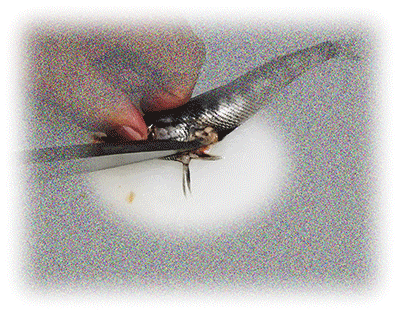
| The above image is during cooking work, but I think you can understand the pelvic fin like two legs. |
|---|
Fish that live on the bottom of the deep sea, such as mehikari, are classified as benthic deep-sea fish, and fish that live drifting off the sea floor, such as the plendid alfonsino, are classified as swimming deep-sea fish. Since the lifestyles of these two types are completely different, it is necessary to distinguish them clearly in terms of evolutionary lineage.
For fish that live in the deep sea where food is scarce, it is important to reduce energy consumption in order to survive, and the fish body stores fat as an energy source for activity. In addition, this fat has the function of adjusting buoyancy so that it does not float or sink even if the fins are not moved, and it also has the function of being able to withstand water pressure. For this reason, deep-sea fish such as Mehikari and Splendid alfonsino have a lot of fat in their bodies, and this fat content contributes to their deliciousness. That's why deep-sea fish store a lot of fat all year round, and even after spawning, you don't need to be too conscious of "out of season because the fat is gone and it's not delicious."
Mehikari is closed nationwide during the spawning months of May and June. However, in Miyazaki Prefecture, one of the production areas of Mehikari, July and August are the peak season for Mehikari, and the common sense that "skinny fish after spawning is not delicious'' is useless for Mehikari. I am writing this article for the May issue at the end of April, so I am not secretly dealing with prohibited fish. April is the time when Mehikari accumulates more fat before spawning to enrich its body. Therefore, even for mehikari fish, which you don't have to be conscious of the season, it's probably the most delicious time of the year.
However, although I said that deep-sea fish are rich in fat and delicious, some fish, especially swimming deep-sea fish, store excess fat to ensure their swimming ability under high water pressure. Among them are oilfish and escolar, which store wax esters, a detrimental quality beyond the level of fat. Since wax esters cannot be broken down by human digestive enzymes, eating them may cause diarrhea, so even if these fish are caught, they are prohibited from being sold.
Commercialization of Mehikari
Well, mehikari, a type of benthic deep-sea fish, has plenty of good-quality fat, so you can eat it deliciously. I would like to introduce part of the cooking process below, but I have to make an excuse. The camera I usually use to shoot the fish work process malfunctioned for a while this time. Each time, the camera was shot from diagonally above my head with a time lapse of 15 seconds, but this time the autofocus function did not work and most of the shots were out of focus. The cause appeared to be that the battery was on the verge of losing its reserves. After I replaced the battery with a fully charged spare battery, the camera was in focus, so the shots I took for a while before the battery was completely discharged seemed out of focus. Therefore, please understand that the following work process is a slightly incomplete description.
First is Mehikari's deep-fried cooking process. Up to this point, the timelapse and autofocus were working and I was able to shoot without going out of focus.
| Mehikari's deep-fried cooking process | |
|---|---|
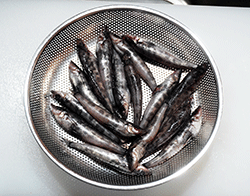 |
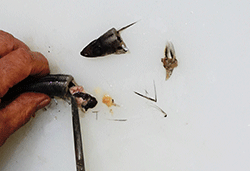 |
| 1,Remove scales and wash with water. | 6,With the abdomen facing down, push the internal organs with your left finger and push out the internal organs using the tip of a kitchen knife. |
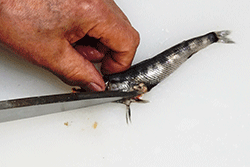 |
 |
| 2,Remove two pelvic fins that are hard and strong like two legs. | 7,The tip of a kitchen knife scoops out the internal organs, but the abdomen is thin and easily torn. |
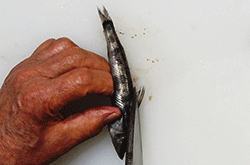 |
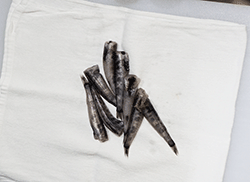 |
| 3,Remove the dorsal fin. | 8,Place the Mehikari from which the internal organs have been removed on a dry towel. |
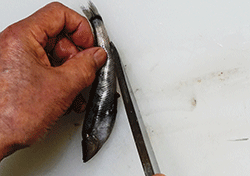 |
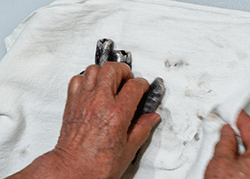 |
| 4,Remove anal fins. | 9,While wiping off the water, remove the remaining internal organs. |
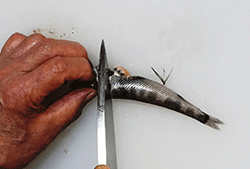 |
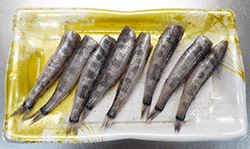 |
| 5,Remove head. | 10,Mehikari with the head cut off and the internal organs removed. |
Next is cooking for sashimi and sushi, but as mentioned above, most of the images in this work process are out of focus and most of them are useless. Among them, the following images were a few usable images.
If there are readers who look at this image and notice "Ah, I remember... this is the method that was done at that time," then that person is definitely a FISH FOOD TIMES heavy user.
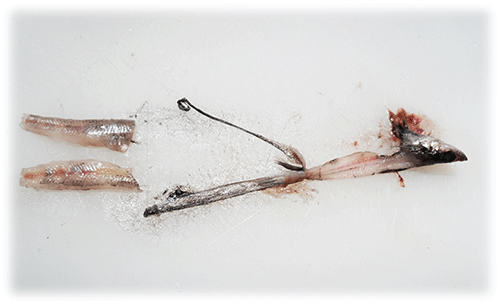
This cooking method was introduced in the August 2019 issue No.188 wrasse nigiri sushi, so if you haven't read it yet, please click and take a look. I think you can understand the explanation by looking at this page, but I can't explain it well with just the image above, so I would like to omit the explanation of the work process.
This time I cooked only 8 fish this way, but when I checked the image after everything was done, most of the process was out of focus... "Achaa... oh my God..." But it was after everything was over, so there was nothing I could do about it.
This method, which completes the process from disassembling three pieces of Mehikari to removing the fish skin at once, is useful when cooking a large number of relatively small fish at a reasonable price. It is especially useful when you need to work quickly. However, Mehikari's bones are small, the skin is thin and easy to cut, and the fish meat is relatively soft, so it is not suitable for speedy and rough handling. For this reason, I used a yanagiba knife instead of a deba knife for everything from disassembling the three pieces to removing the fish skin.
After doing this, the image below is what I ended up with. This was taken with another handheld camera, so there is no out-of-focus.
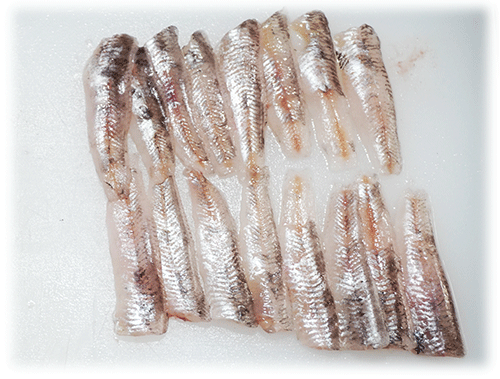
And the following image is commercialized using this skinless half body.
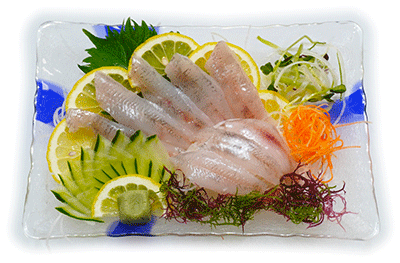
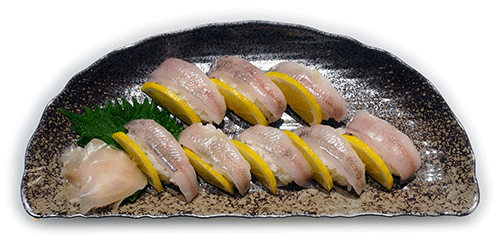
I don't think it's necessary to explain, but sashimi is half of mehikari served on top of shredded Japanese radish, and nigiri-zushi is half of mehikari together with sushi rice. Mehikari has an elongated shape, and sashimi doesn't have any particular problems with that shape. However, if the nigiri sushi is made in a normal shape, the sushi rice will be easier to see from under the mehikari, and this will lose its elegance, so this point was difficult to do. For example, if you use two halves side by side like a small sardine, it will be too wide horizontally, and if you cut it in half, it will be too short. After all, I was careful not to let the sushi rice protrude from under the sushi material by narrowing the rice ball with my middle finger and thumb.
Finally, I made deep-fried, which is the most popular Mehikari dish, so let me introduce the work process with images.
| Mehikari's deep-fried work process. |
|---|
 |
| 1,Prepare Mehikari with the head cut off and the internal organs removed. |
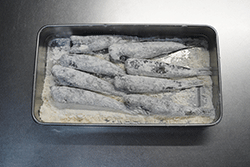 |
| 2,Season with salt and pepper and dust with flour. |
 |
| 3,Put in oil at 180 degrees. |
 |
| 4,After about 5 minutes, when the fish floats to the surface, lightly grab it with the cooking chopsticks, and if a slight vibration is transmitted from the center of the fish to the cooking chopsticks, it is ready. |
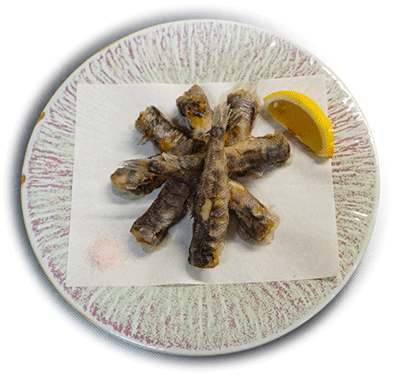 |
| Put the deep-fried on top of the kaishi paper and garnish with cherry salt and lemon to complete. |
These three kinds of Mehikari dishes were delicious with a moderate amount of fat in the raw sashimi and sushi, and the cooked deep-fried had small bones and was soft and easy to eat. Mehikari, a deep-sea fish, is a fish that makes you feel a different taste even if you cook it in the same way as shallow-sea fish such as horse mackerel and sardines. In a sense, these deep-sea fish have not yet fully penetrated ordinary households, and I felt that they are one of the fish that is expected to be developed as an unused resource in the future.
Deep-sea fish for which resource development is expected in the future
I know very little about the deep sea. It seems that a wide variety of creatures inhabit there, but it seems that large fish species are still underutilized in terms of resources. In 2012, at the 3rd "Pursuit of Ideals" (the theme of comprehensive exploitation of deep-sea fish resources) by the Canon Foundation, experts, led by Professor Yoshihiro Ochiai, Faculty of Marine Science and Technology, Tokai University, announced this. I found the article on the web, and I'd like to summarize the gist of it in a not-too-difficult, easy-to-understand format.
| Comprehensive exploration of deep-sea fish resources Project Leader Yoshihiro Ochiai Professor, Faculty of Oceanography, Tokai University |
|---|
The characteristics of deep-sea fish are as follows: (1) In general, they contain a lot of water and a lot of protein. (2) Some species contain harmful wax esters. (3) Contains amino acids (peptides, taurine, anserine, carnosine) with health functions, which are rarely found in shallow-water fish species, and is rich in polyunsaturated fatty acids such as DHA. Therefore, deep-sea fish are potential sources of health functional ingredients.
Fatty fish, on the other hand, may be converted to a good quality paste product by removing harmful lipids (wax esters). In addition, small fish that are difficult to eat (Lanternfish, etc.) can be processed into fish sauce, and there is also a method of using them as feed for farmed fish. The Blackbelly lanternshark off the coast of Sanriku, where a huge amount of resources is predicted, is characterized by a black body color, sharp spines on the dorsal fin, and a species-specific shape of the luminophore. Although this fish is caught in large quantities off the Sanriku coast (about 6 tons per net), it is not used at all and there is little ecological research.
Lanternfish, which is caught as bycatch in cherry shrimp fishing and is expected to have a certain amount of resources, is useful as a raw material for paste products and suitable for processing into fish sauce. Escolar, which is oily fish, is suitable for processing into paste products by degreasing, and good quality kamaboko gel with high gel rigidity can be obtained. In addition, the fat part could be processed into a candle, giving a slightly reddish and gentle flame, with almost no odor, and good quality was obtained.
Species of deep-sea fish that contain harmful waxes are limited, and not only are there no edible problems, but they also contain ingredients that exhibit health functionality. However, many consumers are unfamiliar with deep-sea fish and have a negative image of them. On the other hand, in addition to being used as food, it can be used as feed for farmed fish and as a raw material for useful substances.
In the future, it will be important to develop attractive products as well as dispel the negative image of general consumers. |
This is the summary of the 3rd "Pursuit of Ideals" (the theme of comprehensive exploitation of deep-sea fish resources) by the Canon Foundation. The pie chart above shows the percentage of deep-sea fish in Suruga Bay, with Greeneyes coming in third at 5%. The first Slimehead and the second deep sea smelt are not yet covered by FISH FOOD TIMES. It can be said that the author has left hope for future article development, as it turned out that the number one and number two of the fish species that are often used among deep-sea fish have not been taken up as articles yet.
In recent years, the mass media and other media have taken a conspicuous stance of trying to attract attention by using this method to magnify issues such as global warming as soon as one fish species cannot be caught. The author feels a great sense of incongruity in reporting that "global warming and the depletion of marine resources are being reported in a way that is too easy and without any scientific basis."
To put it bluntly, humans, including the author, know almost nothing about living things in the sea, and it is unlikely that we will be able to easily understand and clarify this scientifically in the future. For example, even above the sea rather than under the sea. The ICPP said that the Pacific islands of Tuvalu may sink due to global warming, but that was years ago... It's probably been at least 20 years since then, but instead of sinking, the landmass of the Tuvalu archipelago is expanding.
It is too frivolous for people who cannot scientifically prove even things on the sea to say that "fishery resources are depleting due to global warming" in the sea. Every time I hear reports like this, I wonder if they are doing some kind of intentional propaganda act to achieve a certain goal. I do not intend to agree with such a folly policy method or idea, but if it is the theory of the Milankovitch cycle of the earth and the regime shift that I have learned in the past, I find it more convincing.
The above is the most I know about Mehikari, which lives in the deep sea. However, there are countless people in the world who do not even know the name of Mehikari, and of course have never eaten it. It is the mission of everyone involved in the fisheries industry to convey the deliciousness of Mehikari to such a large number of people.
Taking this opportunity, I would like you to turn your attention to deep-sea fish and work hard to spread fish consumption from a different perspective than before.
| Please access the following URL if you want to secure using SSL. All pages in the site will be secure pages. |
https://secure02.blue.shared-server.net/www.fish-food.co.jp/message english 5.2023.html |
An opinion and the communication are to iinfo@fish food times
Date of updating 1 May. 2023

